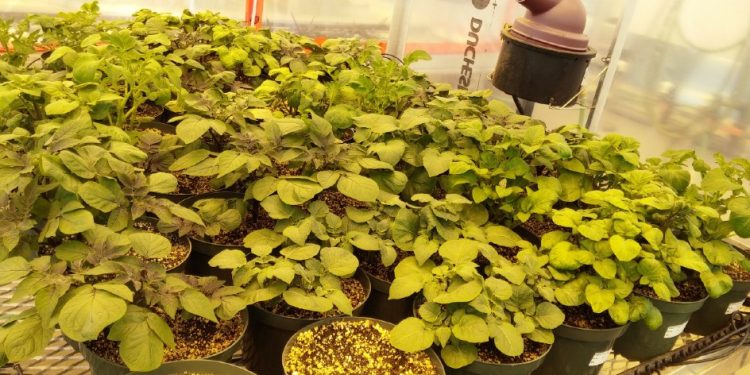Agriculture and Agri-Food Canada (AAFC) scientists in Canada have been studying late blight for many years to ensure that Canada doesn’t fall victim to the destruction that late blight had in Europe centuries ago.
Dr. Bourlaye Fofana is a geneticist with AAFC in Charlottetown, Prince Edward Island (PEI). Most recently he has identified several genes in potatoes that are resistant to another serious disease, common scab. However, his previous research of improving human nutrition through plant products laid the foundation for an important discovery for preventing late blight in potatoes.
In 2014, Dr. Fofana studied how selenium, a micronutrient or mineral that is found in soil, water and some foods, can be boosted in foods such as potatoes, soybean and flax. Selenium is essential to the diets of humans and animals and plays a key role in our metabolism.
According to Dr. Fofana, “Selenium is also an antioxidant, similar to blueberries, which helps reduce the risk of many diseases. I knew that it was possible to increase the health benefit of plants with selenium, but as an antioxidant, can it boost plant immunity against diseases?”

Dr. Fofana and AAFC plant pathologist, Dr. Rick Peters, set out to find an answer to this question. They developed liquid solutions containing various concentrations of selenium and sprayed them onto the leaves of potato plants in the greenhouse at the Harrington Research Farm on PEI.
Following the application of selenium, they injected the plants with late blight disease and then sprayed the plants again with selenium. What they discovered is significant for farmers.
The first spray of selenium solution caused the plant to ready itself to defend against disease and the second spray actually prevented late blight from growing in the potatoes. They got the same results at AAFC’s Charlottetown Research and Development Centre laboratory where selenium stalled the growth of late blight in test tubes.
The results in a controlled greenhouse environment and the lab are remarkable. Due to the risk of the disease spreading, Dr. Fofana could not test this in an outdoor field setting but is confident that the results could be similarily positive for farmers looking to successfully prevent late blight disease in their crops.
“Farmers can use this selenium solution as a preventative measure like they would with a pesticide or herbicide,” says Dr. Fofana. “They can spray their crops in the field or greenhouse with the recommended dose of selenium and that will help the plant to boost its immunity against late blight.”
Dr. Fofana recommends applying selenium to crops when there is no rain in the forecast for one to two days to ensure maximum effectiveness against preventing late blight disease. There are additional benefits of farmers applying this solution. In regions such as PEI where selenium levels are low in soil, this will replenish the micronutrient, helping to improve the plant’s nutritional value.
With another important discovery under his belt, Dr. Fofana isn’t ready to close the book on selenium. He and his team identified genes in potatoes that are activated by the selenium treatment, boosting the plant’s immunity and preventing late blight. They also hope to determine whether selenium can prevent other potato diseases after planting.








